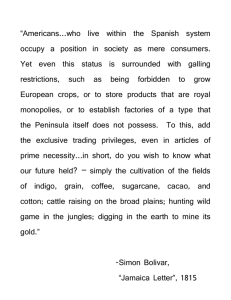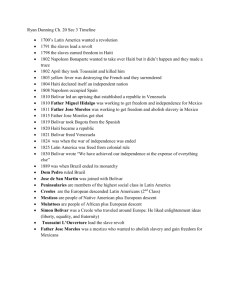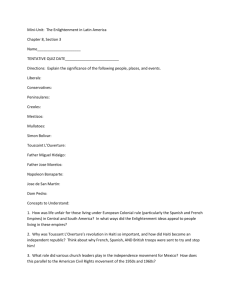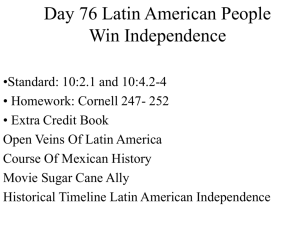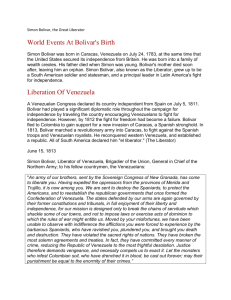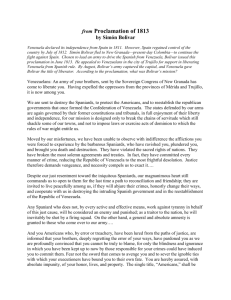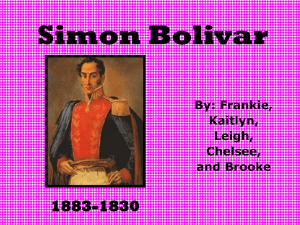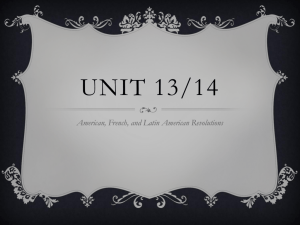Revolutions in Haiti and Latin America: Similar or Different? 1.
advertisement
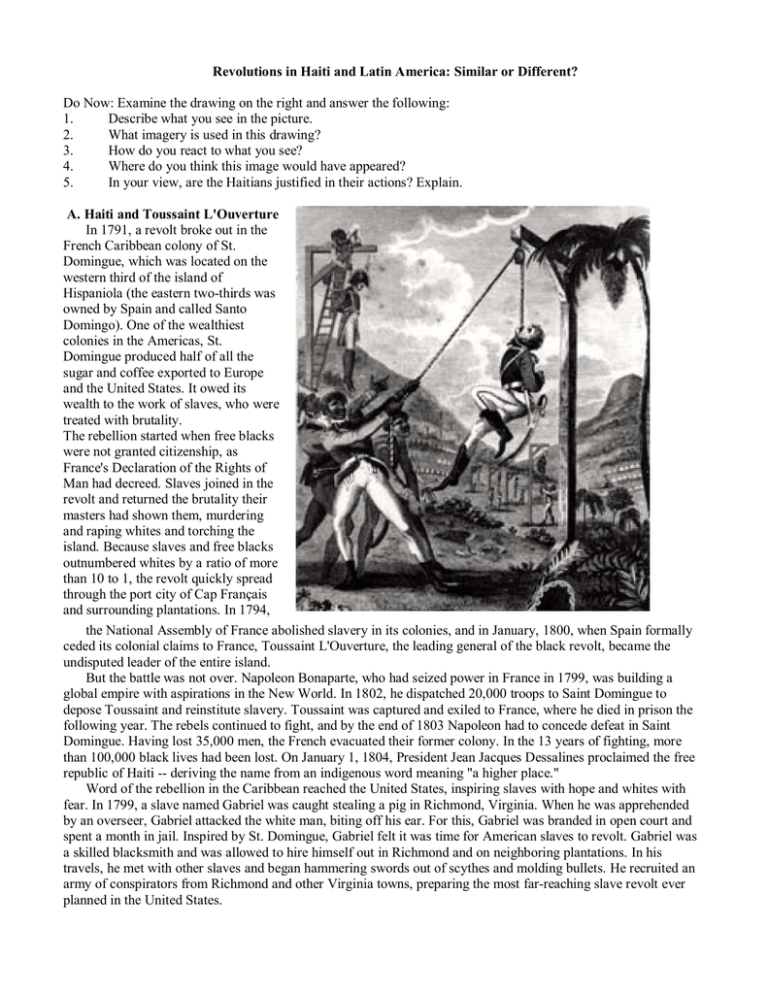
Revolutions in Haiti and Latin America: Similar or Different? Do Now: Examine the drawing on the right and answer the following: 1. Describe what you see in the picture. 2. What imagery is used in this drawing? 3. How do you react to what you see? 4. Where do you think this image would have appeared? 5. In your view, are the Haitians justified in their actions? Explain. A. Haiti and Toussaint L'Ouverture In 1791, a revolt broke out in the French Caribbean colony of St. Domingue, which was located on the western third of the island of Hispaniola (the eastern two-thirds was owned by Spain and called Santo Domingo). One of the wealthiest colonies in the Americas, St. Domingue produced half of all the sugar and coffee exported to Europe and the United States. It owed its wealth to the work of slaves, who were treated with brutality. The rebellion started when free blacks were not granted citizenship, as France's Declaration of the Rights of Man had decreed. Slaves joined in the revolt and returned the brutality their masters had shown them, murdering and raping whites and torching the island. Because slaves and free blacks outnumbered whites by a ratio of more than 10 to 1, the revolt quickly spread through the port city of Cap Français and surrounding plantations. In 1794, the National Assembly of France abolished slavery in its colonies, and in January, 1800, when Spain formally ceded its colonial claims to France, Toussaint L'Ouverture, the leading general of the black revolt, became the undisputed leader of the entire island. But the battle was not over. Napoleon Bonaparte, who had seized power in France in 1799, was building a global empire with aspirations in the New World. In 1802, he dispatched 20,000 troops to Saint Domingue to depose Toussaint and reinstitute slavery. Toussaint was captured and exiled to France, where he died in prison the following year. The rebels continued to fight, and by the end of 1803 Napoleon had to concede defeat in Saint Domingue. Having lost 35,000 men, the French evacuated their former colony. In the 13 years of fighting, more than 100,000 black lives had been lost. On January 1, 1804, President Jean Jacques Dessalines proclaimed the free republic of Haiti -- deriving the name from an indigenous word meaning "a higher place." Word of the rebellion in the Caribbean reached the United States, inspiring slaves with hope and whites with fear. In 1799, a slave named Gabriel was caught stealing a pig in Richmond, Virginia. When he was apprehended by an overseer, Gabriel attacked the white man, biting off his ear. For this, Gabriel was branded in open court and spent a month in jail. Inspired by St. Domingue, Gabriel felt it was time for American slaves to revolt. Gabriel was a skilled blacksmith and was allowed to hire himself out in Richmond and on neighboring plantations. In his travels, he met with other slaves and began hammering swords out of scythes and molding bullets. He recruited an army of conspirators from Richmond and other Virginia towns, preparing the most far-reaching slave revolt ever planned in the United States. 1. 2. 3. 4. Why was Saint Domingue (Haiti) one of the wealthiest colonies in the Americas? Why was the revolt able to spread so easily? How was Haiti finally able to proclaim independence? How did Haiti’s independence influence the United States? Summary Question: In what ways was the Haitain revolution similar to or different from the American Revolution? B. Simon Bolivar, Latin American Liberator During the opening decades of the 19th century, Central and South America turned to revolution. The idea of liberty had stirred the people of Latin America from the time the English colonies gained their freedom. Napoleon's conquest of Spain in 1808 provided the signal for Latin Americans to rise in revolt. By 1822, ably led by Simon Bolivar, Francisco Miranda, Jose de San Martin and Miguel Hidalgo, all of Hispanic America -- from Argentina and Chile in the south to Mexico and California in the north -- had won independence from the mother country. Simon Bolivar was one of South America's greatest generals. His victories over the Spaniards won independence for Bolivia, Panama, Colombia, Ecuador, Peru, and Venezuela. He is called El Liberator (The Liberator) and the "George Washington of South America." Bolivar was born in July 24, 1783, at Caracas, Venezuela. His parents died when he was a child and he inherited a fortune. As a young man, he traveled in Europe. As he returned to Venezuela, Bolivar joined the group of patriots that seized Caracas in 1810 and proclaimed independence from Spain. He went to Great Britain in search of aid, but could get only a promise of British neutrality. When he returned to Venezuela, and took command of a patriot army, he recaptured Caracas in 1813 from the Spaniards. The Spaniards forced Bolivar to retreat from Venezuela to New Granada (now Colombia), also at war with Spain. He took command of a Colombian force and captured Bogota in 1814. The patriots, however, lacked men and supplies, and new defeats led Bolivar to flee to Jamaica. In Haiti he gathered a force that landed in Venezuela in 1816, and took Angostra (now Ciudad Bolivar). He also became dictator there. Bolivar marched into New Granada in 1819. He defeated the Spaniards in Boyar in 1819, liberating the territory of Colombia. He then returned to Angostura and led the congress that organized the original republic of Colombia (now Ecuador, Colombia, Panama, and Venezuela). Bolivar became its first president on December 17, 1819. Bolivar crushed the Spanish army at Carabobo in Venezuela on June 24, 1821. Next, he marched into Educador and added that territory to the new Colombian republic. After a meeting in 1822 with another great liberator, Bolivar became dictator of Peru. His army won a victory over the Spaniards at Auacucho in 1824, which needed Spanish power in South America. Upper Peru became a separate state, named Bolivia in Bolivar's honor, in 1825. The constitution, which he drew up for Bolivia, is one of his most important political pronouncements. 1. 2. 3. 4. 5. What was the inspiration for the Latin American revolutions in the 19th century? How did Napoleon both inspire revolutionary ideas and extinguish revolutionary actions? Why was Simon Bolivar called the “George Washington of South America? Why would Bolivar seek aid from Great Britain? Why was Bolivar a leading force in the revolutions of Latin America? Summary Question: Were the revolutions in Latin American more like the U.S. revolution or the revolutions in Haiti? Explain. Application: Is revolutionary violence against an oppressor justified?
